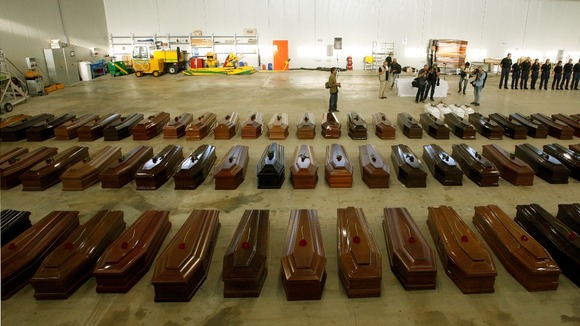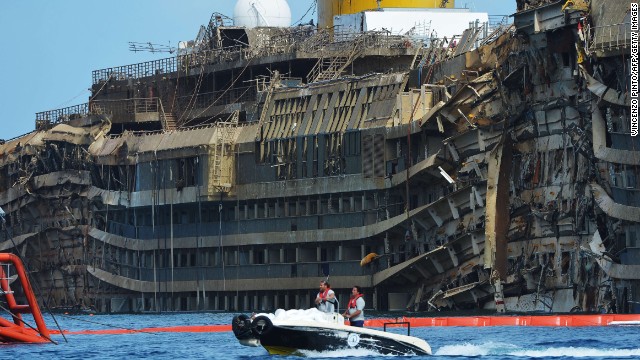
One part heartbreaking study of the drug war that has ravaged Colombia for decades, one part series of meditations on the dead, “Réquiem NN” is a touching visual essay about a small town caught in the midst of a very large and dangerous conflict.
Since 2006, artist Juan Manuel Echavarría has traveled several times to the cemetery of Puerto Berrío, near the Magdalena River, to document the rituals of the local townspeople as they reclaim unidentified victims of the drug war. Fished out of the neighboring river, these No Names (NN) are given new identities by the locals, who also decorate their graves and honor their memories as if for lost relatives.
The film follows the lives of several of the people, from the fishermen who find the bodies, to the doctors who perform the autopsies, to the citizens who take it upon themselves to care for the deceased. Some notable individuals include: Hernán, the “soul keeper,” a sort of caretaker of the dead, performing a midnight mass at the cemetery for the locals; Jair, a man who pays daily visits to the tomb of “Gloria,” a young victim who he claims talks to him in his sleep; and Blanca, a mother who prays every day for the safe return of a missing son and daughter, two innocents possibly caught in the crossfire of the never-ending drug war.
Echavarría has photographed the town for years, and his experience behind the camera is apparent throughout the film. He avoids flashy techniques, keeping the camera trained on the individual as he or she shares a story about a personal encounter with the NNs. One gets the sense that the film is like a moving photo gallery, a fully-sculpted representation of what his photo series evokes. As we follow the separate narratives, Echavarría includes still shots of different tombs, adorned with flowers and plaques bearing the unknown’s new name. Or, he cuts to images of the Magdalena River as it flows lazily by, a swollen body of water filled with gnarled logs and who knows what else, its mysteries hidden beneath the murky surface.
It’s important to note the absence of a soundtrack. Whether that was due to budgetary limitations is not entirely clear, as the film does have a certain stripped-down quality, a refreshing directness in the way it approaches its subject matter. Regardless, it was a wise choice, as throwing in a moody, atmospheric score may seem effective at first thought, but the fact that silence is the general background noise between individual stories allows the viewer to focus even more on what’s on screen. After all, this is a story about a town that, in every moment, is affected by the dead. And cemeteries are quiet places.
If Echavarría has a goal for his documentary other than portraying individual lives affected by the growing number of unknowns, it is the argument of belief as an essential part of a community. There is an accepted notion among locals that providing care for an NN guarantees divine protection and special favors. As such, people rush to claim an NN whenever a new unknown corpse arrives, especially as fire fighters, not local citizens, are the only ones now allowed to retrieve bodies from the river. The medical examiners are frustrated by the local ritual, as they say it gets in the way of their procedures. However, a local cemetery worker argues that it is helpful that people provide individual care for the unknowns, as they willfully pay for separate tombs for the NNs, therefore keeping the unknown from being buried in a mass grave and making it easy to identify the bones later on.
Whether “Réquiem NN” is a series of ghost stories or a straightforward examination of modern life in a war-ravaged country, the people it depicts make it an interesting film. Consider Hernán, the soul keeper. In one scene, he examines a diary of his daily tasks as the resident caretaker of the dead. He expresses weariness in this ongoing relationship with the unknowns. He mentions how he witnessed his first claiming of an NN when he was 14 years old; he is now 57. Or, consider the story of Jesús, a man who lives close to the river and would awaken to the sounds of gunfire. “Bullets were my alarm clock,” he reminisces. He would go to the river and collect the bodies that he always knew were there. Once, he was confronted by the killers, telling him to keep quiet, or what happened to the NN would happen to him, too. Soon after, the thoughts of the dead were always on his mind, to the point that he couldn’t drink anything without tasting blood.
Is this the state of the world? This endless cycle of violence? Echavarría hopes that it isn’t, despite the grim war in his home country. Hope exists throughout the narrative. A fisherman tells a tale of finding a severed head in the waters, but ends with how he offered up a prayer and gave it a proper burial. A mother talks of people promising to exact revenge against the ones who took away her children, but she rebukes this statement, wishing instead for a world without the need for bloodshed. In one poignant scene, we witness two separate families coming together to celebrate the birthday of an NN that they both have claimed. The birthday, as well as the identity of the unknown, are both fabricated—created by the imaginations of those who have chosen to respect the dead in this manner. And yet it is in this act of believing, no matter how farfetched for other cultures, that there lies hope. Perhaps they act in vain, investing money in rituals that only serve to assuage their own guilt. But it is in these choices, in these celebrations against death, that we find our humanity. Through our actions, we defy oblivion.
“Réquiem NN” is showing October 8-14 at The Museum of Modern Art. Running time: 67 minutes; 2013; in Spanish w/English subtitles. Directed by Juan Manuel Echavarría
Tuesday 8 October 2013
http://cinespect.com/2013/10/requiem-nn-reclaiming-the-forgotten/









